| Key Takeaways: • Kajabi is the top choice for those seeking a comprehensive platform for creating, selling, and marketing digital content. It offers an all-in-one solution with a wide collection of features for digital product management. • Patreon is a suitable option if you already have a strong following and don’t need built-in marketing tools. It excels in monetizing content through membership subscriptions but lacks advanced marketing capabilities. |
When it comes to building an online business around your knowledge, skills, or creative talents, the platform you choose can make all the difference. Two of the most popular options are Kajabi and Patreon, both powerful in their own ways, but designed for slightly different use cases.
In this in-depth comparison, we’ll dive into the key features, pros and cons, pricing, and overall user experience of Kajabi and Patreon. By the end, you’ll have a clear understanding of which platform is best suited for your specific needs and goals.
Kajabi vs. Patreon at a Glance
Kajabi and Patreon have some overlapping capabilities, but also notable differences. Here’s a quick side-by-side comparison:
| Feature | Kajabi | Patreon |
| Course Builder | ✅ | ❌ |
| Communities | ✅ | Through apps from third parties |
| Coaching tools | ✅ | ❌ |
| Websites and landing pages | ✅ | ❌ |
| Live streaming | ✅ | Through apps from third parties |
| Automation | ✅ | ❌ |
| Sales funnels | ✅ | ❌ |
| Email marketing | ✅ | ❌ |
| Merch sales | ❌ | ✅ |
What Is Kajabi?

Kajabi is a highly regarded platform designed to build and sell digital products. It offers a comprehensive set of tools to help you create online courses, coaching programs, and membership sites.
With Kajabi, you can easily transform your expertise into a profitable online business, leveraging its all-in-one solution. The platform enables you to develop and manage your digital products and provides features for setting up automated marketing campaigns to boost your sales.
Kajabi’s toolkit includes customizable website templates, email marketing automation, and sales funnel creation. These features make it easier to connect with your audience and drive conversions. Its user-friendly interface ensures that you don’t need extensive technical skills to get started.
Kajabi’s in-depth analytics and reporting tools make it easier to track your business growth. Learn more about Kajabi Analytics & Reporting.
Who Should Use Kajabi?
Kajabi is a great choice for anyone wanting to earn money by sharing their knowledge and skills. If you want to create online courses, build a community, or offer one-on-one coaching, Kajabi has the tools you need to succeed. It works well with different types of online businesses, making it a helpful platform for selling digital products and generating income. Whether you’re a teacher, a coach, or an entrepreneur, Kajabi can support your goals and help you reach more people!
What Is Patreon?

Patreon, on the other hand, is a membership platform that enables creators to monetize their content and build a community of loyal supporters. Rather than selling individual products, Patreon allows you to offer different “tiers” of membership, each with its own exclusive perks and content.
The idea is straightforward: fans subscribe with a monthly fee to enjoy your content, get behind-the-scenes updates, and access special perks. This subscription model works great for creators who already have a loyal following, like artists, musicians, YouTubers, and others.
While Patreon lacks the full-featured marketing and business capabilities of Kajabi, it provides a straightforward way for creators to get paid for their work. It also offers integrations with other digital tools for additional functionality.
Who Should Use Patreon?
Patreon is a suitable choice if you already have an established audience and want to reward them for their support. It’s ideal for content creators who regularly produce high-quality content, such as music, art, videos, or podcasts. With Patreon, you can foster a sense of community among your followers and provide exclusive perks that keep them coming back for more. However, if you’re looking for a platform to help you build and grow your digital business from scratch, Kajabi may be the better option. Overall, both platforms have unique strengths and cater to different types of online businesses.
Kajabi vs. Patreon: Pros and Cons
Both Kajabi and Patreon have their strengths and weaknesses. Here’s a quick overview:
Kajabi Pros:
- All-in-one platform for courses, memberships, and marketing
- Extensive suite of tools and features
- User-friendly interface
- Excellent customer support
- Automated workflows and sales funnels
- Customizable website templates
Kajabi Cons:
- Higher pricing compared to other platforms
- Not suitable for selling physical products
- Limited design customization options for websites and landing pages
For a deeper look into the platform, check out our detailed Kajabi Review: The Good, The Bad, The Ugly to make a more informed decision.
Patreon Pros:
- Free to get started
- Easy way to monetize content through subscriptions
- Ideal for creators with an established following
- Offers integrations with other digital tools for added functionality
- Simple setup process
Patreon Cons:
- High transaction fees
- Lack of built-in marketing capabilities
- Limited features for building a brand or online presence
- Lacks native features for live streaming, video hosting, etc.
Kajabi vs. Patreon: Affordability
When comparing the affordability of Kajabi and Patreon, it’s important to consider their distinct pricing models, as they serve different purposes. Kajabi operates on a subscription-based model. It offers five pricing tiers:
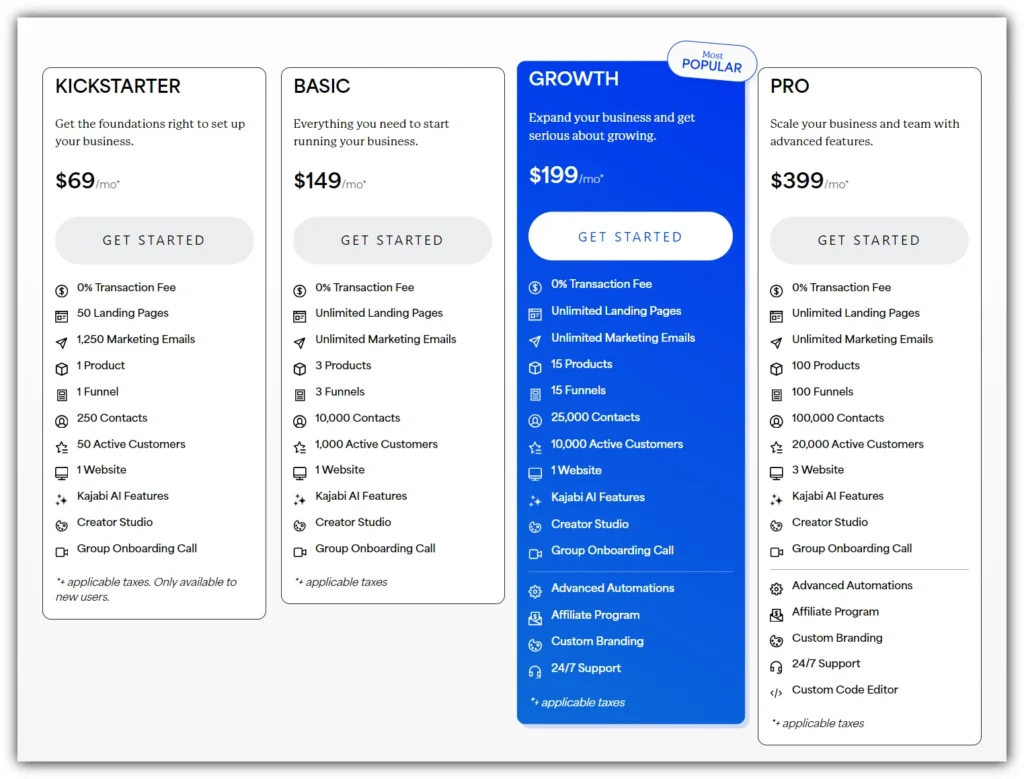
- Kickstarter Plan: $69/month
- Basic Plan: $149/month
- Growth Plan: $199/month
- Pro Plan: $399/month
- Enterprise Plan: Custom pricing (starting at $10,000/year)
Furthermore, Kajabi offers a 20% savings if you choose yearly billing. This indicates that although Kajabi offers an major feature set and tool set for developing and promoting digital products, it necessitates a substantial initial outlay of funds. For people who are just starting out or have a tight budget, this could be a barrier.
In contrast, Patreon has a different approach. It is free to use but takes a percentage of the revenue you generate through the platform. The fee structure for Patreon varies depending on the plan you select: 8%, or 12% of your earnings.
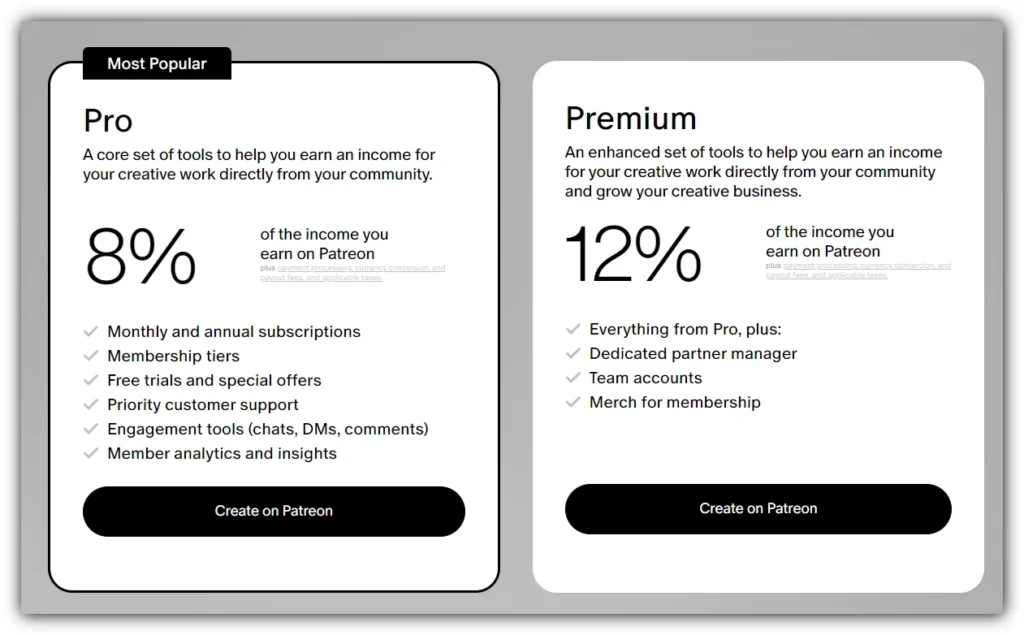
On top of this, there are payment processing fees that apply. Despite these additional costs, Patreon remains more accessible because it does not require an initial investment to get started. Given these factors, Patreon is generally considered the more affordable and accessible option for many users.
Its pay-as-you-earn model means you don’t have to commit to a substantial monthly fee, making it easier for newcomers and those with limited budgets to start monetizing their content. Kajabi’s higher costs can be off-putting for beginners, making Patreon a more appealing choice for cost-conscious creators.
Kajabi vs. Patreon: Monetization Opportunities
When comparing Kajabi and Patreon for monetization, it’s important to understand their respective capabilities and limitations.
Kajabi Monetization Opportunities
Kajabi stands out for its versatility in monetizing digital products. It offers a comprehensive suite of tools that allows you to sell various types of content and services, including:

- Courses and Lessons: Design and sell educational content with ease.
- Communities: Create and manage online communities to foster engagement.
- Live Coaching Sessions: Offer personalized coaching through live sessions.
- Live Streams: Broadcast live events directly on the platform.
- Video or Audio Content: Upload and monetize multimedia content.
- Membership Sites: Set up subscription-based membership sites.
- Masterclasses: Conduct specialized, in-depth classes.
- Digital Downloads: Sell downloadable files like PDFs and templates.
- E-books: Publish and distribute e-books.
- Webinars: Host and sell access to live webinars.
- Podcasts: Monetize podcast episodes with integrated tools.
Kajabi offers a variety of payment options to suit your needs. You can charge customers a single fee, set up payment plans with installments, or provide subscription services. It also lets you bundle products together to create special offers for your customers. However, it’s important to note that Kajabi is mainly built for selling digital products, so it might not be the best choice if you’re looking to sell physical items or run an e-commerce store.
Wondering how Kajabi stacks up against e-commerce giants? Check out Kajabi vs Shopify: Which Platform is Better? for a detailed comparison.
Patreon Monetization Opportunities
Patreon offers a different approach by allowing creators to set up subscription tiers for their supporters. These tiers can include:
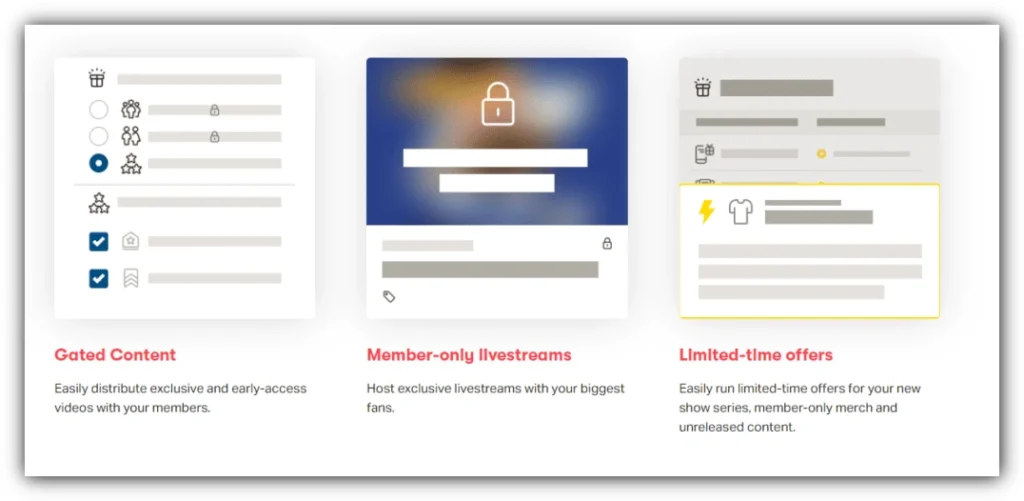
- Newsfeed Updates: Share text, images, and files with your patrons.
- Live Stream Events: Use third-party platforms like Vimeo, YouTube Live, or Crowdcast.
- Video Content: Share videos through URL links or Vimeo integration.
- Digital Downloads: Provide downloadable content.
- E-books: Offer digital books to subscribers.
- Live Chat Rooms: Engage in real-time chats via Discord or Discourse.
- Audio Content: Share audio files with your patrons.
- Merchandise: Sell branded merchandise like stickers, posters, and apparel (note: an additional 3% fee applies).
Patreon’s features often require third-party integrations for live events or video content, which can limit its functionality. Additionally, the platform’s merchandise service incurs extra fees.
Winner: Kajabi
When it comes to monetization opportunities and flexibility, Kajabi wins out. It offers a large selection of digital goods and services that are all combined onto a single platform. It is a complete option for content creators due to its durability in handling different content kinds and payment methods. In contrast, Patreon is less useful for creators looking for an all-in-one solution because, although it is accessible, many of its monetization features necessitate the use of outside tools and services.
Kajabi vs. Patreon: Platform Features
When comparing Kajabi and Patreon, their platform features highlight their distinct focuses and strengths.
Kajabi Features
Kajabi is renowned for its extensive and sophisticated feature set, which justifies its premium pricing. It offers a wide range of tools for creating and managing digital products:
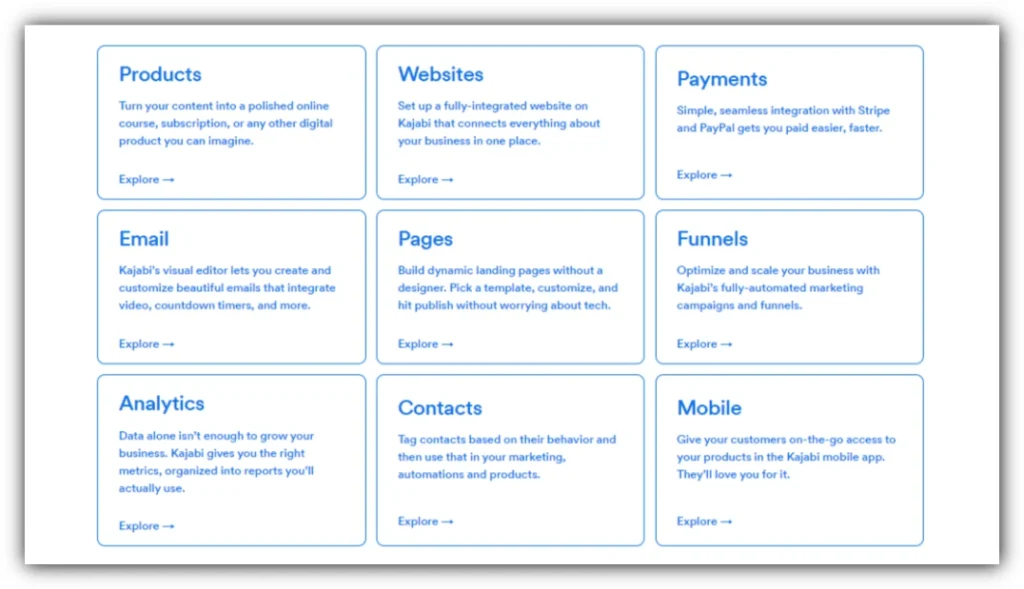
- Course and Lesson Builder: Create and organize educational content with ease.
- Quizzes and Challenges: Engage users with interactive assessments and challenges.
- Email Marketing and Automation: Automate email campaigns and manage communications.
- Sales Funnel and Workflow Builder: Design and automate sales funnels and workflows to drive conversions.
- Landing Page and Website Builder: Create custom landing pages and websites to promote your offerings.
- Blog Creator: Publish and manage blog content to attract and engage visitors.
- Contact Lists and Pipelines: Manage and segment your audience effectively.
- Membership Site Creator: Build and manage membership sites with exclusive content.
- Community Creator: Develop and foster online communities.
- Analytics and Reports: Access detailed analytics and reporting to track performance.
- Mobile App: Available for both creators and customers for on-the-go access.
- SEO-Optimization Tools: Enhance your site’s visibility on search engines.
- Webinars: Host and manage live webinars directly on the platform.
- Coaching Tools: Offer and manage coaching sessions.
- Live Streaming: Broadcast live events and sessions.
- Integrated Payments: Handle transactions with integrated payment processing.
- Flexible Pricing Options and Promotional/Offer Tools: Implement various pricing models and promotions.
- Third-Party Integrations: Connect with other tools and services.
Need inspiration for your Kajabi site? Here are the 15 Best Kajabi Website Examples to help you get started.
Patreon Features
Patreon, on the other hand, has a more streamlined set of native features but relies heavily on third-party applications for additional functionalities:
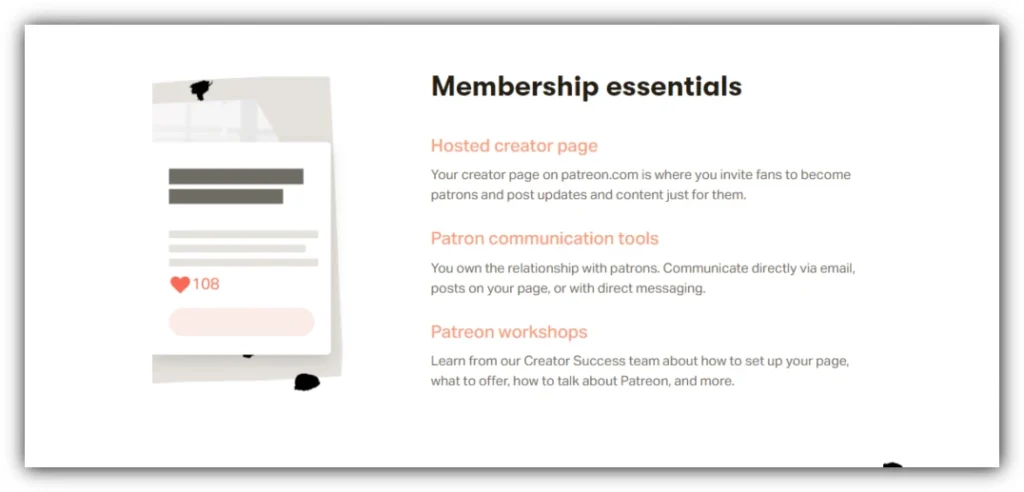
- Customized Creator Page: Personalize your creator page to showcase your content.
- Email and Direct Messaging: Communicate directly with your patrons.
- Mobile App: Access the platform via mobile devices.
- Analytics: Track and analyze your performance on the platform.
- Flexible Pricing Options and Offer Tools: Set up various membership tiers and pricing structures.
- Membership Tier Creation: Create and manage subscription tiers with different benefits.
- Native File Uploads: Upload files directly, including audio files.
- Third-Party Integrations: Use external tools for added functionalities.
- Merch Sales: Sell merchandise with an additional 3% fee per transaction.
Winner: Kajabi
It’s clear that Kajabi wins in terms of platform features. Its extensive toolkit, which is all integrated into one platform, includes everything from advanced marketing automation to course creation. With this huge number of features, managing digital products and interacting with audiences is made easier and more effective. For creators looking for a more merged platform, Patreon might not provide the same level of convenience or integration because it depends on third-party apps for many of its functionalities.
Kajabi vs. Patreon: Integrations
When evaluating Kajabi and Patreon, their integration capabilities highlight their different approaches to extending functionality.
Kajabi Integrations
Kajabi is designed to be a comprehensive all-in-one platform, meaning that many of the essential tools you need are built in. As a result, fewer comprehensive third-party integrations are required.
However, Kajabi does support integrations with some external applications:
- Payment Gateways: Kajabi integrates with PayPal and Stripe for payment processing.
- Email Marketing: Connect with MailChimp for additional email marketing capabilities.
- Analytics: Use tools like Google Analytics for deeper insights.
- Marketing Tools: Integrate with ClickFunnels 2.0 to enhance your marketing strategies.
For additional functionality, Kajabi users can utilize Zapier to connect with thousands of other apps, expanding their integration options further.
Patreon Integrations
Patreon offers a more limited range of native integrations and relies on third-party apps for several features:
- Native Integrations: Includes support for Discord/Discourse for community management, video streaming platforms for live broadcasts, and podcasting tools for content distribution.
- Third-Party Integrations: For additional needs such as email marketing or more advanced analytics, users can connect through Zapier.
One notable advantage of Patreon is its native payment management system, which means there’s no need to integrate with external payment gateways. This simplifies the process of handling transactions.
Winner: Kajabi
Kajabi is the clear winner in terms of integrations. While it offers a robust set of built-in tools, it also provides a range of direct integrations with popular apps for enhanced functionality. This flexibility is complemented by the ability to connect with thousands of other apps through Zapier. Patreon, although useful, has more limited native integrations and relies heavily on third-party apps for many features. This makes Kajabi a more integrated and versatile option for users who need extensive functionality and seamless connectivity.
Kajabi vs. Patreon: User Experience
Kajabi User Experience
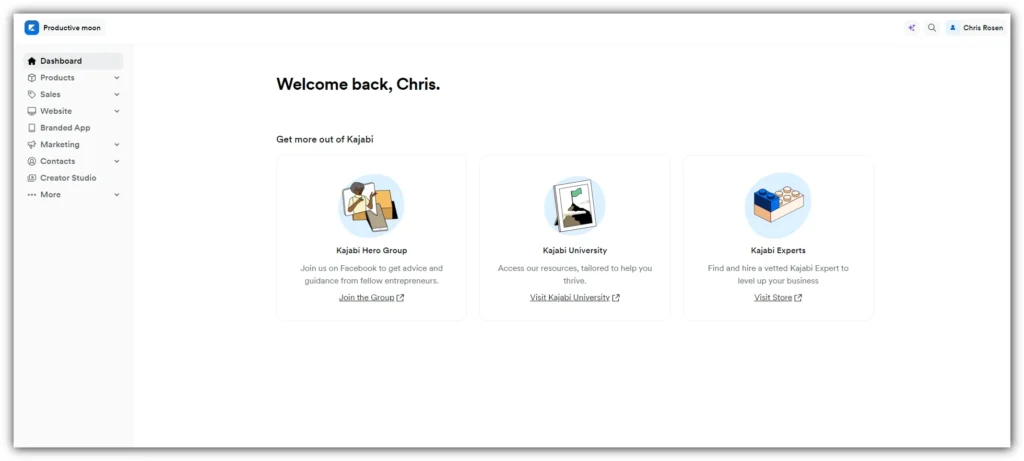
Kajabi is packed with features, but it does take some time to get used to. Fortunately, it’s designed to be user-friendly. Most of the tools are easy to understand and use. If you want to learn about more advanced features like sales funnels, Kajabi provides helpful guides and step-by-step instructions to make the process smoother.
Using Kajabi is typically a straightforward experience, and the layout is made to be enjoyable and easy to navigate. If you run into any challenges, Kajabi has a good learning center where you can find plenty of detailed guides, tutorials, and support articles. These resources make it simple to get answers and learn how to use Kajabi effectively. With this extensive support, even beginners can make the most of what Kajabi has to offer.
Patreon User Experience

Patreon provides a user-friendly experience that’s easy to understand. When you first sign up, you’ll get a helpful checklist that walks you through the steps to set up your page, making sure you don’t miss anything important.
The site itself is simple to use because it has fewer features, which means you can get the hang of it quickly compared to more complicated platforms. However, there is room for improvement in Patreon’s help section. The articles are mostly just text and don’t include many visuals like videos or images, which can make it harder to find the help you need.
Overall, Patreon is a great choice for creators looking to connect with their audience, but enhancing the support resources could make the experience even better.
Winner: Kajabi
Kajabi emerges as the winner in user experience. Its platform operates smoothly, with thoughtful design elements such as prompts and an excellent help center. This broad support and user-friendly interface provide a superior overall experience compared to Patreon’s more limited functionality and less comprehensive support resources.
Kajabi vs. Patreon: Customer Service and Support
When comparing Kajabi vs. Patreon, the level of support provided is a crucial factor to consider.
Kajabi Customer Service and Support
Based on your subscription plan, Kajabi provides a complete support system with different levels of support:
- Basic Plan: Provides live chat support during business hours (6 AM – 5 PM Pacific Time) and email ticketing for inquiries outside these hours.
- Growth or Pro Plans: Upgrade to 24/7 live chat support, ensuring you can get help whenever needed.
The 30-minute live call that Kajabi offers to all new subscribers is a remarkable aspect of their assistance. This onboarding call with an expert helps you get set up, familiarize yourself with the platform, and address any initial questions.
Patreon Customer Service and Support
Patreon offers email ticketing as its primary support channel. However, user reviews often criticize this system for its slow response times, with some users reporting delays of up to a week or no response at all.
Subscribers to the premium plan receive additional support from a dedicated partner manager. This includes personalized coaching, a monthly review, and valuable insights to help optimize your Patreon experience.
Winner: Kajabi
Kajabi stands out as the winner in customer service and support. Its live chat options, especially with 24/7 availability on higher-tier plans, provide a more immediate and reliable support experience compared to Patreon’s slow email responses. The added benefit of a 30-minute onboarding call further enhances Kajabi’s support, making it a superior choice for those seeking prompt and effective assistance.
Kajabi vs. Patreon: Customer Reviews
Reviews from real users are an essential factor to consider when choosing between Kajabi and Patreon.
Kajabi Reviews

Kajabi is a platform that gets a lot of positive feedback from its users. On Trustpilot, it has an impressive score of 4.4 out of 5 based on 1,910 reviews. Many people enjoy using Kajabi because it offers a variety of helpful features and is easy to use. It provides powerful tools for creating and managing online products, making it a popular choice for entrepreneurs and content creators. Users appreciate its straightforward design and the helpful resources available to guide them.
One common concern mentioned by users is the cost. Some find Kajabi a bit expensive, but most feel that the benefits they gain from using the platform justify the price. Overall, the response has been very positive, with many users believing that Kajabi offers great value for the investment.
Patreon Reviews

Patreon has received mixed reviews from its users. On sites like Capterra and G2, many people like Patreon because it’s easy to use and offers flexible payment options. These features make it simple for users to handle their memberships and the content they provide.
However, reviews on Trustpilot tell a different story. Patreon has a low rating of 1.3 out of 5 based on 641 reviews. A significant reason for this unfavorable feedback is the accusation that the platform supported Russia during its invasion of Ukraine in 2022, which led many users, especially non-subscribers, to voice their criticism.
Overall, users who actively engage with Patreon generally appreciate how straightforward it is to navigate and how effectively it helps them manage their memberships. Still, there are some complaints, especially regarding customer service and the lack of built-in tools. These issues can make the platform less efficient and not as user-friendly as many would prefer.
Conclusion
In short, choosing between Kajabi and Patreon really comes down to your specific business needs and goals. If you’re looking to build a comprehensive online platform to create, market, and sell a wide range of digital products, Kajabi is the stronger choice. Its all-in-one suite of features gives you the tools to handle everything from course creation to email automation, making it a powerful option for serious digital entrepreneurs.
On the other hand, if you already have an engaged audience and simply want an easy way to monetize your content through membership subscriptions, Patreon may be the simpler, more affordable solution. Its streamlined approach is well-suited for creators who don’t need the full suite of marketing capabilities that Kajabi provides.
Ultimately, evaluate your requirements, whether that’s the breadth of features, pricing constraints, or the nature of your online business. Whichever platform aligns best with your needs will be the better fit to help you achieve your goals.
Frequently Asked Questions
Which Is More Cost-Effective – Kajabi or Patreon?
Kajabi’s pricing starts at $69 per month for the Kickstarter Plan, while Patreon takes a 5% commission on your total earnings. Depending on your business needs and revenue, either platform could be more cost-effective.
How Do Kajabi and Patreon Differ?
Kajabi is an all-encompassing platform designed for creating, marketing, and selling digital products. It offers a broad collection of features, including tools for course creation, sales funnels, and email marketing. This makes Kajabi ideal for those who need a comprehensive solution for handling and promoting digital products.
In contrast, Patreon is geared towards helping creators earn money through membership subscriptions. It provides essential tools for managing memberships and delivering content to supporters but lacks built-in marketing tools and features for digital product creation. Patreon is more suitable for creators who already have a following and want to monetize their content through subscriber-based models.
Which Platform Is Easier to Use?
Both Kajabi and Patreon offer user-friendly interfaces that are relatively easy to navigate. However, Kajabi may have a slight edge with its more extensive range of features and resources available for guidance.
Can I Import My Content from Patreon to Kajabi?
Yes, you can import your content from Patreon to Kajabi but be aware that the process is not automatic. You will need to manually upload each piece of content, which can be time-consuming if you have a lot of material on your Patreon page already.
Can I Use Both Kajabi and Patreon Together?
Yes, you can use both platforms together to complement each other’s features. For example, you could use Kajabi to create and sell courses while using Patreon as an additional way to monetize memberships with exclusive content or perks.
Which Is Better – Kajabi or Patreon?
Kajabi is preferable for digital product creators seeking a powerful platform to create, market, and sell their products. Its broad suite of features and integrated tools offer a complete solution for managing all aspects of a digital business.